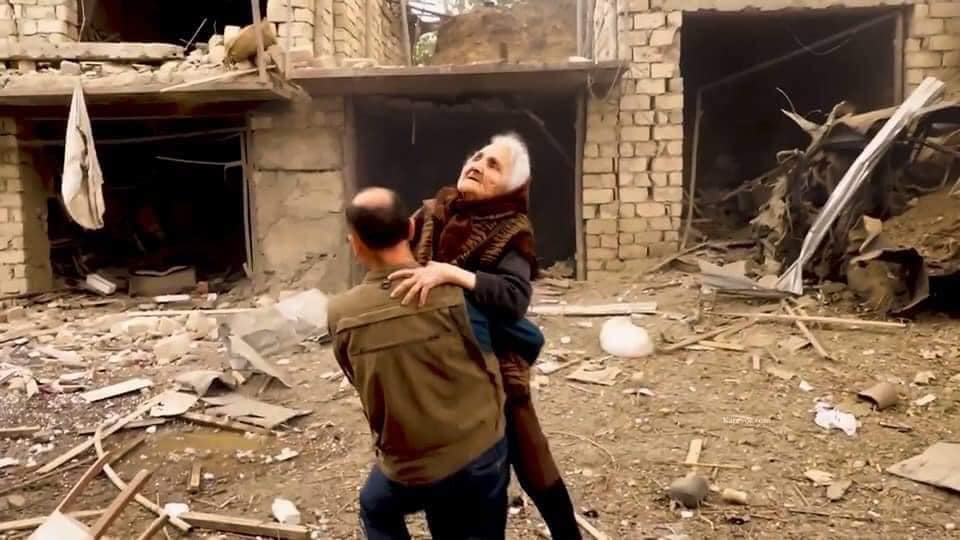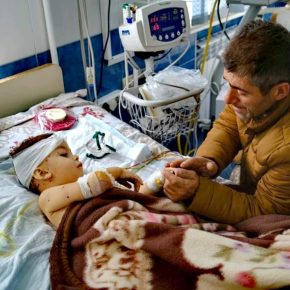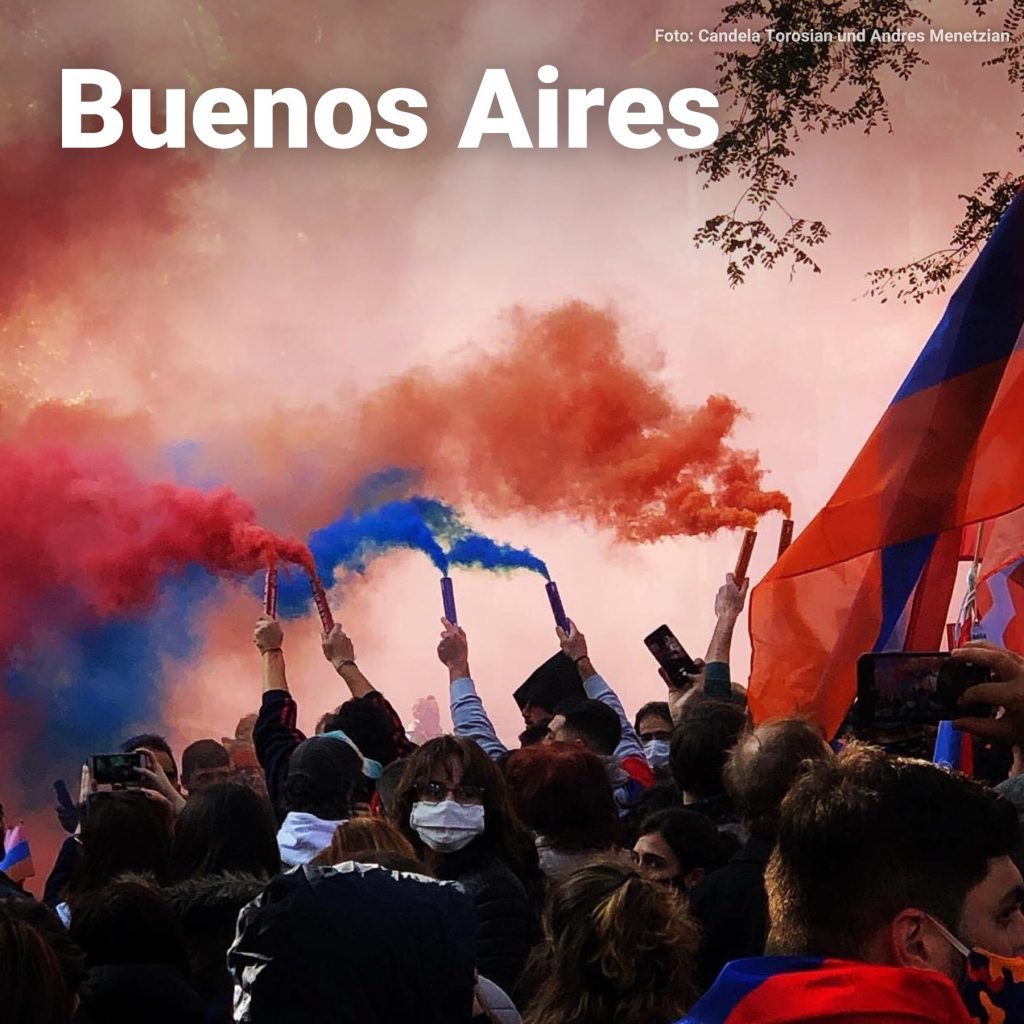The Ongoing Situation
Since September 27 there has been an all-out war reigniting a thirty-year conflict between Azerbaijanis and Armenians over disputed territory known both as Nagorno Karabakh and the Republic of Artsakh. Although, the land is internationally recognized as a territory of Azerbaijan it is inhabited by over 95% ethnic Armenians.
Here is a map for reference.
In short, Nagorno Karabakh was established by the U.S.S.R. in 1923 as an autonomous oblast within Soviet Azerbaijan. Both Armenia and Azerbaijan were governed bloc countries. In 1988, ethnic Armenians living in Nagorno Karabakh, after a history of conflict with ethnic Azerbaijanis, determined they were no longer willing to exist within Soviet Azerbaijan domain and voted successfully to join Soviet Armenia. The USSR Supreme Soviet, however, adopted a resolution in 1990 describing the Armenian vote to secede, without Azerbaijan SSR`s consent, illegal. Then, on Dec 25, 1991, the Soviet Union dissolved, erupting in years of conflict, including the Balkan Wars, massive outbreaks of crime, civilian unrest, and food shortages, all of which led to rebel groups attempting to create independent states.
In the absence of Soviet rule, and faced with political instability in Azerbaijan, independent Armenian military groups entered Nagorno Karabakh in 1994 in an effort to secure the autonomous region; an action that was welcomed by the ethnic Armenian majority then suffering in the disputed territory. This was met with resistance from Azerbaijani forces resulting in a conflict that left approximately 30,000 military and civilians dead. Later that year, a cease fire agreement was reached, followed by resolutions, skirmishes, and continued negotiations that have left the disputed territory in much the same state it was in 1994 – Azerbaijan claims ownership, backed by Soviet decree, with the land inhabited and governed by Armenians.
In 2017, Nagorno Karabakh officially became the “Republic of Artsakh” after 88% of voters in the disputed territory approved the name change, which may or may not have contributed to increased tensions resulting in the Sept 2020 warfare.
- The Bombing of Stepanakert began Sept 27, 2020
- Artsakh
- photos | ARM Unified infocenter
Today, among scanty media coverage and academic reviews, there can be found perspectives that suggest peace is possible, that this war is just another forgettable skirmish between two tiny countries, two tribes, who cannot seem to work out their differences – Basically, another day in the desensitized digital age.
For additional context, read here, here, and here.
The situation is thus; civilians and towns are bombed daily, and young bright souls continue to die in the fight to preserve what remains of the Armenian lands, Armenian culture, Armenian way of life – herein lies the ugly truth of war, whatever the reasons, innocent lives are lost on all sides. War isn’t pretty. In this, some fight, some bake, some pray.
- Hospitalized Armenian citizens
- photos by Areg Balayan
- A father comforts his injured child
“The most disappointing part of this entire conflict is the deafening silence from the international community and the press.” ~ Margarita Baghdasaryan, Office of the High Commissioner for Diaspora Affairs
As a Christian nation, largely surrounded by Muslim nations, a fact which must be noted, Armenians have been present in the South Caucasus and Anatolia for millennia, and since the widely unrecognized genocide of 1.5 million Armenians, now 105 years ago, it concerns the Armenian global community to see Turks yet again aiding in the destruction of Armenia – this time in conjunction with Azerbaijani war crimes.
“When a country like Turkey isn’t punished for crimes they committed against a race, they have the green light to do it again,” says Raffi Ourlian, Chairperson of the Armenian Revolutionary Federation (ARF), Detroit chapter. “Accountability is critical.”
For Armenians, the memories of genocide and deep-rooted emotions of loss remain. Meanwhile, the U.S., which has never fully recognized the Armenian genocide, is for now sitting this one out.
Beside an unconfirmed report of a Turkish F-16 (American made jet) shooting down an Armenian SU-25 in Armenian airspace, it is confirmed that Turkey has been hiring and transporting hundreds, if not thousands, of Syrian mercenaries to fight for Azerbaijan. Sadly, many of these men are just another pawn dying at the front for the Turkish-backed promise of $1,500 a month.
The voice of mainstream media and influential governments around the world have, for the most part, these past thirty years, ignored or misrepresented the victims and the aggressors, instead attempting to take an objective stance by assessing the transgressions of both sides equally. In this instance, naming the aggressors is objective, and critical. Assuming both sides are in the war for the same reasons is incorrect.
Yes, the 4,400sq miles that comprise Artsakh is a ‘territorial’ component of the war, primarily for the Azerbaijanis, but no, this war is far greater than that of land. Today, for the people of Artsakh, it is a fight in defense of humanity, of freedom, of sanctity and sovereign sanctuary away from persecution – a people whom have never called themselves Azerbaijani, regardless of the territorial owner. Here, it is both a war about the land, and perhaps more so, about who lives on the land – a historically, complicated matter, with multiple omissions and transgressions on both sides.
Today, the Republic of Artsakh is incredibly homogenous and for decades its people have aimed to separate entirely from Azerbaijan, either to join Armenia or to become their own sovereign nation; something many sovereignties, post-colonial states and native peoples around the world should understand – a natural will and definitive human right to be able to live freely outside of persecution and oppression.
Dictatorship and Democracy
To paint another picture – there is the United States, a country that preaches pro-democracy and touts freedom. Many international affairs the U.S. has been involved in promote the greater calling of ‘let the people speak’ – a refrain that should support the Armenian vote for sovereignty. However, apart from a September Reuters report there has been little on the subject outside of President Trump saying, “We’ll see if we can stop it.”
Next, Turkey; a NATO ally member that is effectively a dictatorship, and “friend with benefits” to the United States and most of the ‘West’, has supplied Azerbaijanis with aircraft, as well as financing mercenaries to the front.
Then there is Azerbaijan. Since 2015, a growing number of reputable international media opinions have called Azerbaijan and the Aliyev regime a “dictatorship” and country that continually jails journalists.
Israel, a people one would think should recognize hatred and genocide, are currently supplying Azerbaijanis with weaponry, ‘kamikaze drones,’ cluster bombs, and military supplies.
President Emmanuel Macron has been somewhat outspoken in France, claiming they have evidence of Turkish involvement. However, Macron has yet to act beyond a “war of words” with Turkish President Tayyep Erdoğan.
On this, Celine Kaladjian, a French-Armenian videographer based in Marseille says, “Since the conflict has started, I’m in fear every time I open Facebook. This is such a horrendous feeling: you’re here, living your life while your friends are dying . . . I also wish that for once some countries, such as France, would clearly take a stand to put an end to this ugly and meaningless war before it’s gone too far.”
The currency of this war is emblematic and quite literally one of the few stones left that block the ideological war path of Turkish imperialism in the region. There are reports of renewed forms of Turkish aggression in Cyprus. Then, of course, there is the Turkish interference in the Libyan civil war, aggression in Syria, continued persecution of Kurdish people, and antagonism against Greece and Iraq. For over a century Turkey has continued its policy of smoke and mirrors, followed by the bombing of its international neighbors.
All of this has left Armenia isolated, a country of which recently went through a ‘velvet revolution,’ a bloodless revolution, in an effort to solidify democracy and stamp out old oligarchic guards.

Armenians in Detroit protest the bombing of their homeland | by Nareh Vartanian
The Russians
One possible saving grace card for the Armenians, and one of which it is likely nobody really wants played, is Russian interference. The Russians have a military base in Armenia. I was there two years ago, in the northwest. The young men marched through the square and side-streets of Gyumri on Sundays, displaying their tan and red colors – symbolizing some sort of quasi protectorate of the Armenians, as well as a distinct memory of when Armenia was ruled by the Soviets. And too, the annexation of Ukraine’s Crimean Peninsula, dispenses legitimate pause between ally and subject. Just this month, Ukraine and Turkey signed a military cooperation deal, interestingly followed by Erdoğan’s position that “Turkey has not recognized Crimea’s illegal annexation and it never will.” If Russia does help the Armenians, what will be the asking price?
In a brief interview with Arman Gasparyan, a resident of Gyumri and survivor of the 1988 Spitak earthquake, he shared that he had just returned home, after burying a close relative who was killed near Jebrail, in the southern conflict zone. Like many of those who have been killed thus far, his relative was young.
“How did we get here? That is because of the silence, idleness of all international units like OSCE, UN, NATO, EU, etc. and very many corrupted politicians and media worldwide,” Gasparyan said. “If all the nations who want peace in the world start pressing their governments there will be peace.”
While in Istanbul
Last year in Istanbul, it was unavoidable to see the face of Erdoğan and the immense nationalistic psyche and physical red and crescent propaganda blankets covering the people of Turkey. In a café with some middle-aged locals in the Karaköy district, we conversed on the nature of their country’s military might. It was their opinion that the power of the United States was to deceive and to dominate. Their gist was that to have their own will known to the world, that is the Turkish will, it must be through an ‘iron fist’ – a parallel I could not deny. This perspective was reiterated to me several times, in several forms, while in Turkey; by policemen, bar attendants, and men with smoke above their wide bellies.
Though, I must give the Turkish youth some credit. Listening to academic lectures in art galleries and code-switching whispers in darkly lit alleyways, with more radically minded ‘tost’ eating gatherers, I listened and scribbled in my journal. I heard the questions and pondering of young persons as they assessed what is happening along their southern border with Syria, and elsewhere. I heard their voices – youth who questioned the propaganda that so entrenched their country.
While in Istanbul, I traveled to the Hagia Sofia. At the foot of the monument were “heroic” photographs of Atatürk on display in a large plaza. Around fifty photographs were blown up and set on easels. These images that sought to uplift the power of a man, a nation, were guarded by men with assault rifles.
Cyprus and Elsewhere
In 1974, Turkey invaded north Cyprus. Shortly, after my time last year in Istanbul, I flew to the Turkish occupied side of Cyprus, an island full of Greek and Turkish Cypriots, Maronites, and Armenians. I sat with a man named Geordi (not his real name) in Nicosia/Lefkoşa, over pastry and tea, and spoke of the many stone walls and fences that divide a city once whole. Geordi is a lawyer that works with people inside the buffer zone or ‘green line,’ a small area between both sides. He represents the complexities of people stuck between existential threat and daily life. Above us waved three small flags – a white and blue Greek flag, Cypriot flag, and the ancient yellow flag of the Byzantine empire. In the distance, a Turkish Cypriot flag.
Listening to Geordi then, reminded me of stories shared by a dear Greek islander friend of mine, Cynthia Zambaros from Ikaria. In the 1970’s, her family and others were forced to flee their homes in a dramatic night of lightless, soundless row boats. The Turkish army were an Aegean island over and the Greeks were on the lookout for fire-signaling enemy spies.
Multiple times, while in Nicosia, I passed through the passport checkpoint, from one side to other. Red signs and threatening crosses were splattered along a desolate corridor translated as ‘no pictures.’ Men sat at both sides of the checkpoint looking lazily into the sun, investigating bags, mostly ushering European tourists eager to get their exotic Mediterranean holiday. I had love in my heart, but it was unavoidable to see the delicacy of social and psychological life of Cypriots on both sides of the ‘green-line.’
In Armenia’s capital city, Yerevan, resident Nancy Nersisyan recounts the feeling on the morning of September 27 – when the war picked up steam – “I was running to work, unaware of what happened. As soon as I got there, I saw everybody was in distress . . . all of us were forced to organize aid to the border. Every time a new list of dead soldiers comes out, I scan it a couple times to make sure there is nobody I know. Even if they are a stranger it makes me anxious to read their name, because that person was an important part of someone’s life.”
- Global protests for Armenia are happening in over 50 cities
- Photos | permission released by Haypress
Calling Media and Free Nations
In Yerevan, Armenian resident Margarita Baghdasaryan, who works in the government Office of the High Commissioner for Diaspora Affairs, said “The most disappointing part of this entire conflict is the deafening silence from the international community and the press. The “west” pretends to uphold values like justice, democracy, and freedom but remains silent when a small nation’s right to exist is threatened by two dictators.”
While hoping for peaceful resolve, I note these perspectives from Armenia, Cyprus, Turkey and elsewhere. Each day, I wake up disappointed in ‘Western’ media, national and local, who ignore or take indifferent positions on the atrocities against the Armenian people.
“All we ask the media to do is report the truth,” said Raffi Ourlian (ARF) in Detroit. “What’s not being reported is that Jihadists and ISIS fighters have been imported by Turkey to Azerbaijan to kill Armenians.”
In a very real way, another Armenian generation is living an inter-generational trauma clock that keeps getting reset. Today, on six continents there are fighters of injustice, Armenian diaspora, and allies of humanity – protesting in the streets. All of this in front of the world’s powers, and yet, the world continues to sit.
One piece of long-term hope that I cling to are the outspoken voices of Azerbaijani youth and activists, whom like some of their Turkish youth counterparts, as well as ‘no-war Westerners,’ put into question or flatly condemn the actions of their governments.
My one wish – peace.
______________________________________________________________
How to Help
You can donate.
The best source for this is armeniafund.org or himnadram.org. You can also share reputable news sources, some of which are linked in this article. You can call your representatives and push for resolutions like Michigan representative Amara Manoogian’s sharp resolution condemning Azerbaijan, or sign online petitions like this one and this one.
If you have a company, consider matching donation drives or raising awareness, like Ara the Rat, a clothing brand, which raised $30,000.
Or, you can start creative fundraisers or hold events, as many allies and Armenians are doing today. Such as Levon Kafafian who contributed a heartfelt piece of poetry in an online performance and community gathering event which raised $1,180. Or like Anaeis Ohanian in Los Angeles, who has raised $1,000 so far through face painting and social media channels.
Written by Julién Godman • Feature Image courtesy of ARM • Photographers Areg Balayan, Nareh Vartanian ° Managing Editor, Julién Godman • Editor Anthony Brancaleone












